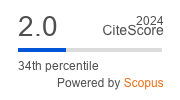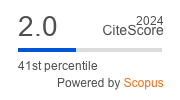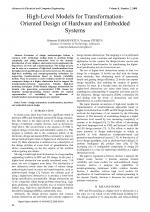| 2/2008 - 16 | View TOC | « Previous Article | Next Article » |
High-Level Models for Transformation-Oriented Design of Hardware and Embedded SystemsDAMASEVICIUS, R. |
| Extra paper information in |
| Click to see author's profile in |
| Download PDF |
Author keywords
design automation, transformation, hardware and embedded system design
References keywords
design(37), model(29), software(22), systems(17), embedded(13), system(12), driven(12), damasevieius(11), stuikys(10), development(9)
Blue keywords are present in both the references section and the paper title.
About this article
Date of Publication: 2008-06-02
Volume 8, Issue 2, Year 2008, On page(s): 86 - 94
ISSN: 1582-7445, e-ISSN: 1844-7600
Digital Object Identifier: 10.4316/AECE.2008.02016
Web of Science Accession Number: 000264815000016
SCOPUS ID: 77954751851
Abstract
Evolution of design methodologies follows a common trail: technology scaling leads to growing design complexity and rising abstraction level in the domain. Introduction of new (higher) abstraction levels emphasizes the importance of reuse and transformations. The design process can be seen as a sequence of high-level transformations from the higher-level specification to the lower-level one. We analyze high-level modeling and metaprogramming techniques for supporting transformations based on domain variability models. Next, we present a reuse evolution model for domain component design at a higher abstraction level to support the transformation-oriented approaches. Finally, high-level modeling techniques (UML-domain language metamodels for domain code generation, parameterized UML classes for template metaprogramming, feature models for explicit representation of variability) for specification of transformations and metaprograms are analyzed. |
| References | | | Cited By «-- Click to see who has cited this paper |
| [1] L. Lavagno, G. Martin, B. Selic (eds.). UML for Real: Design of Embedded Real-Time Systems. Kluwer Academic Publishers, 2003.
[2] M. Keating, P. Bricaud. Reuse Methodology Manual for System-on-a-Chip Designs. Kluwer Academic Publishers, 2001. [3] A. Sangiovanni-Vincentelli, G. Martin, "Platform-based design and software design methodology for embedded systems", IEEE Design and Test of Computers, 18(6), 2001, pp. 23-33. [CrossRef] [SCOPUS Times Cited 289] [4] B. Bailey, G. Martin, T. Anderson (eds.). Taxonomies for the Development and Verification of Digital Systems. Springer, 2005. [5] A. Jantsh, S Kumar, A. Hemani, "Ruby: A metamodel to study concepts in electronic system design", IEEE Design & Test of Computers, 2001. [6] L.P. Carloni, F. De Bernardinis, A. L. Sangiovanni-Vincentelli, M. Sgroi, "The art and science of integrated systems design", Proceedings of the 28th European Solid-State Circuits Conference ESSCIRC, 2002, pp. 25-36. [7] W. Mûller, W. Rosenstiel, J. Ruf. SystemC: Methodologies and Applications. Kluwer Academic Publishers, 2003. [8] G. Martin, "IP reuse and integration in MPSoC: Highly configurable processors", MPSoC'04, 8 July 2004. [9] E. Aarts, R. Roovers, "IC design challenges for ambient intelligence", Proc. of Design, Automation and Test in Europe Conf. (DATE 03), Munchen, Germany, 3-7 March 2003, pp. 2-7. [10] H.-K. Kim, "Applying Product Line to the Embedded Systems", Proc. of Int. Conf. on Computational Science and Its Applications, ICCSA 2006, Glasgow, UK, May 8-11, 2006. LNCS 3982 Springer 2006, Part 3, pp. 163-171, 2006. [11] G. Martin, "UML for embedded systems specification and design: motivation and overview", Proc. of Design Automation and Test in Europe (DATE 2002), 4-8 March 2002, Paris, France, pp. 773-775. [12] M. Edwards, P. Green, "UML for hardware and software object modeling", in L. Lavagno, G. Martin, B. Selic (eds.), UML for Real, Kluwer Academic Publishers, 2003, pp. 127-148. [13] G. Jong, "A UML-based design methodology for real-time and embedded systems", Proc. of Design Automation and Test in Europe (DATE 2002), 4-8 March 2002, Paris, France, pp. 776-778. [14] Q. Zhu, A. Matsuda, S. Kuwamura, T. Nakata, M. Shoji, "An object-oriented design process for System-on-Chip using UML", Proc. of the 15th Int. Symp. on System Synthesis (ISSS 2002), October 2-4, 2002, Kyoto, Japan, pp. 249-254. [15] T. Beierlein, D. Frvhlich, B. Steinbach, "Model-Driven compilation of UML-models for reconfigurable architectures", in 2nd RTAS Workshop on Model-Driven Embedded Systems (MoDES '04), Toronto, Ontario, Canada, May 25-28, 2004. [16] T. Schattkowsky, W. Müller, "Model-based design of embedded systems", Proc. of 7th IEEE Int. Symposium on Object-Oriented Real-Time Distributed Computing (ISORC'04), May 12 - 14, 2004, Vienna, Austria, pp. 121-128. [17] D.H. Akehurst and S.J.H. Kent, "A relational approach to defining transformations in a metamodel", in J.-M. Jezequel, H. Hussmann, S. Cook, eds. UML 2002 - The Unified Modeling Language: 5th International Conference, Springer-Verlag, 2002, pp. 243 - 258. [18] J.M. Favre, "Metamodels and models co-evolution in the 3D software space", In ELISA 2003, associated with ICSM 2003, Amsterdam, The Netherlands, September, 2003. [19] K.-K. Lau and Z. Wang, "A Taxonomy of software component models", in 31st Euromicro Conference on Software Engineering and Advanced Application, August 31-September 2, Porto, Portugal, 2005. [20] R. Gitzel, T. Hildenbrand. A Taxonomy of metamodel hierarchies. Research Report, Department of Information Systems. University of Mannheim, 2005. [21] R. Damasevieius, "On the Application of Meta-Design Techniques in Hardware Design Domain", International Journal of Computer Science (IJCS), Vol. 1, No. 1, pp. 67-77, 2006. [22] F. Doucet, S. Shukla, R. Gupta, "Introspection in System-Level Language Frameworks: Meta-level vs. Integrated", Proc. of Design Automation and Test in Europe Conference (DATE 2003), 3-7 March 2003, Munich, Germany, 382-387. [23] F. Seyler, P. Aniorte, "A Component metamodel for reuse-based system engineering", Workshop in Software Model Engineering, October 1st 2002, Dresden, Germany. [24] D. Orr, "Model driven software development through the integration of three models", OOPSLA Workshop on Best Practices for Model Driven Software Development, 2005. [25] G. Karsai, M. Maroti, A. Ledeczi, J. Gray, J. Sztipanovits, "Composition and cloning in modeling and Metamodeling", IEEE Trans. on Control Systems Technology 12 (2004), pp. 263-278. [CrossRef] [SCOPUS Times Cited 59] [26] B. Schätz, A. Pretschner, F. Huber, J. Philipps, "Model-based development of embedded systems", in J.-M. Bruel, Z. Bellahsene (Eds.), Advances in Object-Oriented Information Systems (OOIS'2002) Workshops, Montpellier, France, Springer LNCS, 2002. [27] R. Damasevieius, V. Stuikys, "Application of UML for Hardware Design Based on Design Process Model", Asia South Pacific Design Automation Conference (ASP-DAC 2004), January 27-30, 2004, Yokohama, Japan, pp. 244-249. [28] L. Tratt, "Model transformations and tool integration", Journal of Software and Systems Modelling, 4(2), May 2005, pp. 112-122. [CrossRef] [SCOPUS Times Cited 75] [29] A. Ledeczi, G. Nordstrom, G. Karsai, P. Völgyesi, M. Maróti, "On metamodel composition", Proc. of the IEEE Int. Conference on Control Applications, CCA 2001, Mexico City, Mexico, pp. 756-760. [30] P.-A. Muller, P. Studer, J.-M. Jezequel, "Model-driven generative approach for concrete syntax composition", OOPSLA & GPCE Workshop on Best Practices for Model Driven Software Development, Vancouver, 2004. [31] T. Levendovszky, G. Karsai, M. Maroti, A. Ledeczi, H. Charaf, "Model reuse with metamodel-based transformations", in C. Gacek, (ed.), Proc. of 7th Int. Conf. on Software Reuse: Methods, Techniques, and Tools, ICSR, LNCS vol. 2319. Springer, 2002, pp. 166-178. [32] S. Deelstra, M. Sinnema, J. van Gurp, J. Bosch, "Model driven architecture as approach to manage variability in software product families", Proc. of Workshop on Model Driven Architecture: Foundations and Applications (MDAFA'2003), June 2003, pp. 109-114. [33] J. van Wijngaarden, E. Visser. Program Transformation Mechanics: A Classification of Mechanisms for Program Transformation with a Survey of Existing Transformation Systems. Technical Report UU-CS-2003-048, Institute of Information and Computing Sciences, Utrecht University, May 2003. [34] L. Kuzniarz, M. Staron, "On model transformations in UML-based software development process", Software Engineering and Applications'03, Marina del Rey, CA, 2003. [35] K. Czarnecki, S. Helsen, "Classification of model transformation approaches", OOPSLA'03 Workshop on Generative Techniques in the Context of Model-Driven Architecture, 2003. [36] W. Wu, I., Sander, A. Jantsch, "Transformational system design based on a formal computational model and skeletons", Forum on Design Languages (FDL'2000), September 4-8, 2000, Tübingen, Germany. [37] O. de Moor, G. Sittampalam, "Generic program transformation", Proc. of the 3rd Int. Summer School on Advanced Functional Programming, Braga, Portugal, September 12-19, 1998, Springer LNCS 1608, pp. 116-149, 1999. [38] T. Mens, K. Czarnecki, P. van Gorp, "A Taxonomy of Model Transformations", in J. Bezivin, R. Heckel (Eds.), Proc. of Language Engineering for Model-Driven Software Development, 29 February - 5 March 2004. Dagstuhl Seminar Proceedings 04101, Schloss Dagstuhl, Germany 2005. [39] M. Gogolla, A. Lindow, M. Richters, P. Ziemann, "Metamodel Transformation of Data Models", Workshop in Software Model Engineering, October 1st 2002, Dresden, Germany. [40] S. Nedunuri, W. Cook, "Transforming Declarative Models Using Patterns in MDA", OOPSLA & GPCE Workshop on Best Practices for Model Driven Software Development. Vancouver, 2004. [41] S.R. Judson, R.B. France, D.L. Carver, "Specifying model transformations at the metamodel level", WiSME@UML'2003 - UML Workshop in Software Model Engineering, October 21, 2003, San Francisco, USA. [42] J. Kovse, "Generic model-to-model transformations in MDA: Why and How?", in OOPSLA 2002 Workshop on Generative Techniques in the context of Model Driven Architecture. Seattle, November 4-8, 2002. [43] R. Damasevieius, V. Stuikys, "Soft IP customization models based on high-level abstractions", Information Technology and Control, 2005, Vol. 34, No. 2, pp. 125-134. [44] V. Stuikys, R. Damasevieius, "Metaprogramming techniques for designing embedded components for ambient intelligence", in T. Basten, M. Geilen, H. de Groot (eds.), Ambient Intelligence: Impact on Embedded System Design. Kluwer Academic Publishers, 2003, pp. 229-250. [45] E.A. Lee, A. Sangiovanni-Vincentelli, "A Framework for comparing models of computation", IEEE Transactions on CAD, Vol. 17, No. 12, 1998, pp. 1217-1229. [46] M. Sgroi, M. Sheets, A. Mihal, K. Keutzer, S. Malik, J. Rabaey, A. Sangiovanni-Vincentelli, "Addressing the system-on-a-chip interconnect woes through communication-based design", Proc. of Design Automation Conference, 18-22 June 2001, pp. 667-672. [47] J. Rowson, A. Sangiovanni-Vincentelli, "Interface-based design", Proc. of the 34th Design Automation Conference (DAC 97), June 9-13, 1997, Anaheim, CA, USA, pp. 178-83. [48] L. Entrena, C. Lopez, E. Olias, "Automatic generation of fault tolerant VHDL designs in RTL", Forum on Design Languages FDL'2001, Lyon, France, 2001. [49] R. Damasevieius, V. Stuikys, E. Toldinas, "Embedded program specialization for multiple criteria trade-offs", Electronics and Electrical Engineering, 8(88), pp. 9-14, 2008. [50] M. Kuulusa, J. Nurmi, J. Takala, P. Ojala, H. Herranen, "A flexible DSP core for embedded systems", IEEE Design & Test of Computers, October-December, 1997, pp. 60-68. [51] Domain Engineering and Domain Analysis, Software Technology Roadmap. http//www.sci.cmu.edu/str/descriptions/deda_body.html, 2005. [52] A. Gerstlauer, D.D. Gajski, "System-level abstraction semantics", Proc. of 15th Int. Symposium on System Synthesis (ISSS'02), October 2-4, 2002, Kyoto, Japan, pp. 231-236. [53] R. Damasevieius, V. Stuikys, "Wrapping of Soft IPs for Interface-based Design Using Heterogeneous Metaprogramming", INFORMATICA, 2003, Vol. 14, No. 1, pp. 3-18. [54] B.W. Boehm, "A spiral model of software development and enhancement", IEEE Computer, 1988, 21(5):61-72. [55] T. Sheard, "Accomplishments and research challenges in meta-programming", in 2nd Int. Workshop on Semantics, Application, and Implementation of Program Generation (SAIG'2001), Florence, Italy. LNCS, vol. 2196, 2001, Springer, pp. 2-44. [56] V. Stuikys, R. Damasevieius, "Variability-Oriented Embedded Component Design for Ambient Intelligence Systems", Information Technology and Control, 36(1), pp. 16-29, 2007. [57] V. Stuikys, R. Damasevieius, G. Ziberkas, "Open PROMOL: An experimental language for domain program modification", in A. Mignotte, E. Villar, L. Horobin (Eds.), System on Chip Design Languages, Kluwer Academic Publishers, 2002, pp. 235-246. [58] V. Stuikys, R. Damasevieius, "Soft IP customization model based on metaprogramming techniques", INFORMATICA Vol. 15, No. 1, 2004, pp. 111-126. [59] Object Management Group (OMG). MOF: MetaObject Facility. http://www.omg.org/mof/ [60] UMLStudio. http://www.pragsoft.com. [61] R. Damasevieius, G. Majauskas, V. Stuikys, "Application of Design Patterns for Hardware Design", Proc. of 40th Design Automation Conference DAC 2003, June 2-6, Anaheim, CA, USA, pp. 48-53. [62] K.C. Kang, J. Lee, and P. Donohoe, "Feature-Oriented Product Line Engineering", IEEE Software, 19(4):58-65, 2002. [63] R. Damasevieius, V. Stuikys, E. Toldinas, "Domain Ontology-Based Generative Component Design Using Feature Diagrams and Meta-Programming Techniques", in R. Morrison, D. Balasubramaniam, and K. Falkner (Eds.), Proc. of 2nd European Conference on Software Architecture ECSA 2008, September 29 - October 1, Paphos, Cyprus. LNCS 5292, pp. 338-341. Springer-Verlag, 2008. [64] D. Abrahams, A. Gurtovoy. C++ Template Metaprogramming: Concepts, Tools, and Techniques from Boost and Beyond. Addison-Wesley, 2004. Web of Science® Citations for all references: 0 SCOPUS® Citations for all references: 423 TCR Web of Science® Average Citations per reference: 0 SCOPUS® Average Citations per reference: 7 ACR TCR = Total Citations for References / ACR = Average Citations per Reference We introduced in 2010 - for the first time in scientific publishing, the term "References Weight", as a quantitative indication of the quality ... Read more Citations for references updated on 2025-07-01 08:34 in 22 seconds. Note1: Web of Science® is a registered trademark of Clarivate Analytics. Note2: SCOPUS® is a registered trademark of Elsevier B.V. Disclaimer: All queries to the respective databases were made by using the DOI record of every reference (where available). Due to technical problems beyond our control, the information is not always accurate. Please use the CrossRef link to visit the respective publisher site. |
Faculty of Electrical Engineering and Computer Science
Stefan cel Mare University of Suceava, Romania
All rights reserved: Advances in Electrical and Computer Engineering is a registered trademark of the Stefan cel Mare University of Suceava. No part of this publication may be reproduced, stored in a retrieval system, photocopied, recorded or archived, without the written permission from the Editor. When authors submit their papers for publication, they agree that the copyright for their article be transferred to the Faculty of Electrical Engineering and Computer Science, Stefan cel Mare University of Suceava, Romania, if and only if the articles are accepted for publication. The copyright covers the exclusive rights to reproduce and distribute the article, including reprints and translations.
Permission for other use: The copyright owner's consent does not extend to copying for general distribution, for promotion, for creating new works, or for resale. Specific written permission must be obtained from the Editor for such copying. Direct linking to files hosted on this website is strictly prohibited.
Disclaimer: Whilst every effort is made by the publishers and editorial board to see that no inaccurate or misleading data, opinions or statements appear in this journal, they wish to make it clear that all information and opinions formulated in the articles, as well as linguistic accuracy, are the sole responsibility of the author.



